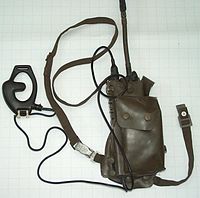SEM 52 A
| SEM 52 A | |
|---|---|

|
|
| SEM52 with accessories | |
| Technical specifications | |
| Frequency range | 47.0 to 57.975 MHz |
| Number of channels | 6 out of 400 |
| Transmission power | 0.2 watt |
| sensitivity | 0.5 µV with a signal / noise ratio of 20 dB |
| Modulation: | FM |
| Type of traffic | Intercom |
| measurements and weight | |
| height | 180 mm |
| width | 85 mm |
| depth | 36 mm |
| Weight | 0.65 kg |
| Further data | |
| Manufacturer | Standard electrical system Lorenz |
| Application area | Bundeswehr (1971–1984) |
The transmitter / receiver, mobile SEM 52 A was the standard handheld radio introduced by the Bundeswehr in 1971 and the first fully transistorized handheld radio in the army .
The VHF radio was developed in 1968 by Standard Elektrik Lorenz . With the device, six channels out of 400 possible were switchable. For channels 1 to 4 there were 24 interchangeable channel inserts, 4 of which were in a container. The frequencies 47.8 MHz on channel 5 and 55.5 MHz on channel 6 were identical for all SEM 52 A of the Bundeswehr.
The device consisted of a transmitter / receiver housing, headset, antenna and carrying case. The power supply was carried out with six AA - batteries - or accumulators . The intercom could be attached to the paddock, was protected against EMP radiation and had a maximum range of about five kilometers on flat terrain.
The SEM 52 A was originally intended to be replaced by the SEM 53 prototype developed in 1972 , but was then replaced by the further developed SEM 52 S in the Bundeswehr in 1984 .